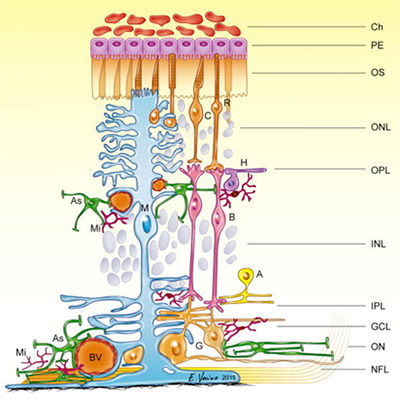Neuroprotection in the retina: the study of glial-neuron interactions
The aim of these studies is to understand the molecular mechanisms that cause the death of a specific type of neuron in the retina, the Retinal Ganglion Cells (RGCs) that are responsible for carrying signals from the eye to the brain. These neurons are the most sensitive to insults and those that die in the largest numbers in Glaucoma, the world's leading cause of blindness. UPV/EHU and the University of Bordeaux.

1. Experimental models of Glaucoma
1.1. Animal models
Our group has been a world pioneer in the development of pre- and post-trabecular glaucoma models, which are now being used worldwide to determine the causes of glaucoma and to develop treatment strategies.
These models have helped us to develop research projects leading to Phase III clinical trials of iRNA therapies to lower intraocular pressure. This project was carried out in collaboration with the company “Sylentis”, part of the CELTIA group, and with the group of Prof. María José Alonso, an expert in the field of nanoparticles at the School of Pharmacy of the University of Santiago de Compostela.
Representative publications:
- Urcola, J.H. et al., 2006. Three experimental glaucoma models in rats: Comparison of the effects of intraocular pressure elevation on retinal ganglion cell size and death. Exp Eye Res. 83(2):429-37.
- Vecino, E. et al., 2018. Ocular Hypertension/Glaucoma in Minipigs: Episcleral Veins Cauterization and Microbead Occlusion Methods. Methods Mol Biol. 1695:41-48.
Projects:
- Development of personalized treatments for glaucoma focusing on the paediatric and elderly populations. GLAUKUS. RETOS-MINECO (CHALLENGES-MINECO), ERDF funding (RTC-2016-4823-1)
- Development of Neuroprotective Therapies for eye diseases. Consolidated Group funding from the Basque Government (IT437-10)
1.2. Cannabinoids
We also participate in a collaborative project with Dr Giovanni Marsicano at the Magendie Institute of Neurosciences of the University of Bordeaux, which aims to study the Neuroprotective and Neuromodulatory effect of Cannabinoids in glaucoma. Sandra Beriain is a graduate student responsible for carrying out this research as part of her doctoral thesis, which is supervised jointly by Dr Marsicano and Prof. Vecino.
Prof. Vecino began this project during a sabbatical at the University of Bordeaux under the framework of the Initiative of Excellence of the University of Bordeaux (IdEx Bordeaux) in 2020.
Representative publications:
- Pinar-Sueiro S, Zorrilla Hurtado JÁ, Veiga-Crespo P, Sharma SC, Vecino E.. Neuroprotective effects of topical CB1 agonist WIN 55212-2 on retinal ganglion cells after acute rise in intraocular pressure induced ischemia in rat. Exp Eye Res. 2013 May;110:55-8. doi: 10.1016/j.exer.2013.02.009. Epub 2013 Feb 20. PMID: 23454099
- Pinar-Sueiro S, Rodríguez-Puertas R, Vecino E. Cannabinoid applications in glaucoma. Arch Soc Esp Oftalmol. 2011 Jan; 86(1):16-23. doi: 10.1016/j.oftal.2010.11.015. Epub 2011 Feb 24.PMID: 21414525 Review. Spanish.
2. Glial-Neuron interactions
2.1. Müller glia
We study the relationship between Müller glial cells, the main glial cell type in the retina, and retinal ganglion cells. We have proposed different glial-neuronal interactions that promote ganglion cell survival.
In collaboration with the University of Coimbra (Portugal), our study currently aims to identify the molecules implicated in these interactions that are secreted by Müller cells by analyzing the extracellular vesicles released by these cells (e.g., microvesicles and exosomes). These studies will be carried out both under control conditions and under conditions of elevated hydrostatic pressure, the latter allowing us to simulate the main feature of glaucoma in vitro. At present, Dr Xandra Pereiro is the beneficiary of a post-doctoral Basque Government fellowship to undertake the collaborative research between the UPV/EHU and the University of Coimbra.
Representative publications:
- Garcia, M. et al., 2002. Effects of Muller glia on cell survival and neuritogenesis in adult porcine retina in vitro. Invest Ophthalmol Vis Sci. 43(12):3735-43.
- Vecino, E. et al., 2016. Glia–neuron interactions in the mammalian retina. Prog Retin Eye Res. 51:1-40.
- Ruzafa, N. et al., 2018. A Proteomics Approach to Identify Candidate Proteins Secreted by Müller Glia that Protect Ganglion Cells in the Retina. Proteomics. 18(11).
- Pereiro, X. et al., 2020. Optimization of a Method to Isolate and Culture Adult Porcine, Rats and Mice Müller Glia in Order to Study Retinal Diseases. Front Cell Neurosci. 14:7.
2.2. Microglia
In collaboration with Dr Jimena Baleriola, we are co-supervising the Doctoral Thesis that is being undertaken by the graduate student Maite Blanc at the Achucarro Neuroscience Institute. The study focuses on analysing the local protein synthesis of microglial cells.
Representative publications:
- Blanco-Urrejola, M. et al., 2021. RNA Localization and Local Translation in Glia in Neurological and Neurodegenerative Diseases: Lessons from Neurons. Cells. 10(3):632.
3. Neurodegenerative Diseases and the Retina
3.1. Parkinson’s and Alzheimer’s disease
We study the impact of diseases like Parkinson's and Alzheimer's disease on the visual system. It is known that the neurons of the retina are affected in neurodegenerative diseases. Using animal models of Parkinson's and Alzheimer's disease, we study the extent to which the different type of neurons in the retina are affected in these conditions by immunohistochemistry.
Collaborative UPV/EHU project with the Department of Pharmacology and with the Achucarro Neuroscience Institute. Associated with a Gangoiti Foundation fellowship to the graduate student Lara Rodríguez.
3.2. PRGF
We are studying the effect of Plasma Rich in Growth Factors (PRGF) on neuroprotection in the retina and its possible inflammatory effects.
Representative publications:
- Ruzafa, N. et al., 2021. Plasma Rich in Growth Factors (PRGF) Increases the Number of Retinal Müller Glia in Culture but Not the Survival of Retinal Neurons. Front Pharmacol. 12:606275.
- Ruzafa, N. et al., 2021. The Effect of Plasma Rich in Growth Factors on Microglial Migration, Macroglial Gliosis and Proliferation, and Neuronal Survival. Front Pharmacol. 12:606232.
